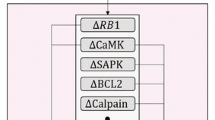Summary
There is now convincing evidence that the calcium ion plays a critical role in cytotoxicity and cell death. In a variety of experimental models cell killing has been found to be preceded by intracellular Ca2+ accumulation, and pretreatment with Ca2+ entry blockers or intracellular Ca2+ chelators has been shown to provide protection. Further, resistance to cell killing has been reported to correlate with cellular levels of the Ca2+-binding protein calbindin-D28k in neurons and thymoma cells. It is also clear that sustained increases in intracellular Ca2+ level can activate cytotoxic mechanisms which result in perturbations of cell structure and function. For example, the stimulation of Ca2+-dependent proteases can cause a disruption of cytoskeletal organization, and Ca2+-mediated phospholipase activation can result in an impairment of mitochondrial function and cessation of ATP synthesis. The activation of Ca2+, Mg2+-dependent endonuclease(s) is associated with characteristic chromatin cleavage which is a hallmark of apoptotic cell killing in the immune system and other tissues. The aim of this overview is to discuss some recent advances in our knowledge of the role of the calcium ion in cytotoxicity.
Access this chapter
Tax calculation will be finalised at checkout
Purchases are for personal use only
Preview
Unable to display preview. Download preview PDF.
Similar content being viewed by others
References
Carofoli E, Penniston JT. The calcium signal. Sci. Am. 1985; 253: 70.
Carofoli E. Intracellular calcium homeostasis. Ann. Rev. Biochem. 1987; 56: 395–433.
Carofoli E. The Ca2+ pump of the plasma membrane. J. Biol. Chem. 1992; 267: 2115–2118.
Bellomo G, Mirabelli F, Richelmi P, Malorni W, Iosi F, Orrenius S. The cytoskeleton as a target in quinone toxicity. Free Rad. Res. Commun. 1990; 8: 391–399.
Mirabelli F, Salis A, Vairetti M, Bellomo G, Thor H, Orrenius S. Cytoskeletal alterations in human platelets exposed to oxidative stress are mediated by oxidative and Ca2+-dependent mechanisms. Arch. Biochem. Biophys. 1989; 270: 478–488.
Eriksson JE, Paatero GIL, Meriluoto JAO, Codd GA, Kass GEN, Nicotera P et al. Rapid microfilament reorganization induced in isolated rat hepatocytes by microcystin-LR, a cyclic peptide toxin. Exp. Cell Res. 1989; 185: 86–100.
Carini R, Bellomo G, Dianzani MU, Albano E. Evidence for a sodium-dependent calcium influx in isolated hepatocytes undergoing ATP depletion. Biochem. Biophys. Res. Commun. 1994; 202: 360–366.
Whitehouse LW, Paul CJ, Thomas BH. Effect of acetylsalicylic acid on a toxic dose of acetaminophen in the mouse. Toxicol. Appl. Pharmacol. 1976; 38: 571–582.
Guarner F, Boughton-Smith NK, Blackwell GJ, Moncada S. Reduction by prostacyclin of acetaminophen-induced liver toxicity in the mouse. Hepatology 1988; 8: 248–253.
Horton AA, Wood JM. Effects of inhibitors of phospholipase A2, cyclooxygenase and thromboxane synthetase on paracetamol hepatotoxicity in the rat. Eicosanoids 1989; 2: 123–129.
Horton AA, Wood JM. Prevention of Ca2+ induced hepatocyte plasma membrane bleb formation by inhibitors of eicosanoid synthesis. J. Lipid Mediator 1989; 1: 213–242.
Wyllie AH, Kerr JFR, Currie AR. Cell death: The significance of apoptosis. Int. Rev. Cytol. 1980; 68: 251–305.
Jiang S, Chow SC, Nicotera P, Orrenius S. Intracellular Ca2+ signals activate apoptosis in thymocytes: Studies using the Ca2+-ATPase inhibitor thapsigargin. Exp. Cell Res. 1994; 212: 84–92.
McConkey DJ, Hartzeil P, Håkansson H, Orrenius S. 2,3,7,8-Tetrachlorodibenzo-p-dioxin kills immature thymocytes by Ca2+-mediated endonuclease activation. Science 1988; 242: 256–259.
Baffy G, Miyashita T, Williamson JR, Reed JC. Apoptosis induced by withdrawl of interleukin-3 (IL-3) from an independent hemapoietic cell line is associated with reparti-tioning of intracellular calcium and is blocked by enforced Bcl-2 oncoprotein production. J. Biol. Chem. 1993; 268: 6511–6519.
Heizmann CW, Hunziker W. Intracellular calcium-binding proteins: more sites than insights. Trends Biochem. Sci. 1991; 16: 98–103.
Heizmann CW, Braun K. Changes in Ca2+-binding proteins in human neurodegenerative disorders. Trends Neurosci. 1992; 15: 259–264.
Pedrocchi M, Schafer BW, Mueller H, Eppenberger U, Heizmann CW. Expression of Ca2+-binding proteins of the S100 family in malignant human breast-cancer cell lines and biopsy samples. Int. J. Cancer 1994; 57: 684–690.
Author information
Authors and Affiliations
Editor information
Editors and Affiliations
Rights and permissions
Copyright information
© 1995 Birkhäuser Verlag Basel/Switzerland
About this chapter
Cite this chapter
Bellomo, G., Carafoli, E., Heizmann, C.W., Horton, A., Orrenius, S. (1995). Calcium-Dependent Mechanisms in Drug Toxicity and Cell Killing. In: Cuello, A.C., Collier, B. (eds) Pharmacological Sciences: Perspectives for Research and Therapy in the Late 1990s. Birkhäuser Basel. https://doi.org/10.1007/978-3-0348-7218-8_46
Download citation
DOI: https://doi.org/10.1007/978-3-0348-7218-8_46
Publisher Name: Birkhäuser Basel
Print ISBN: 978-3-0348-7220-1
Online ISBN: 978-3-0348-7218-8
eBook Packages: Springer Book Archive




